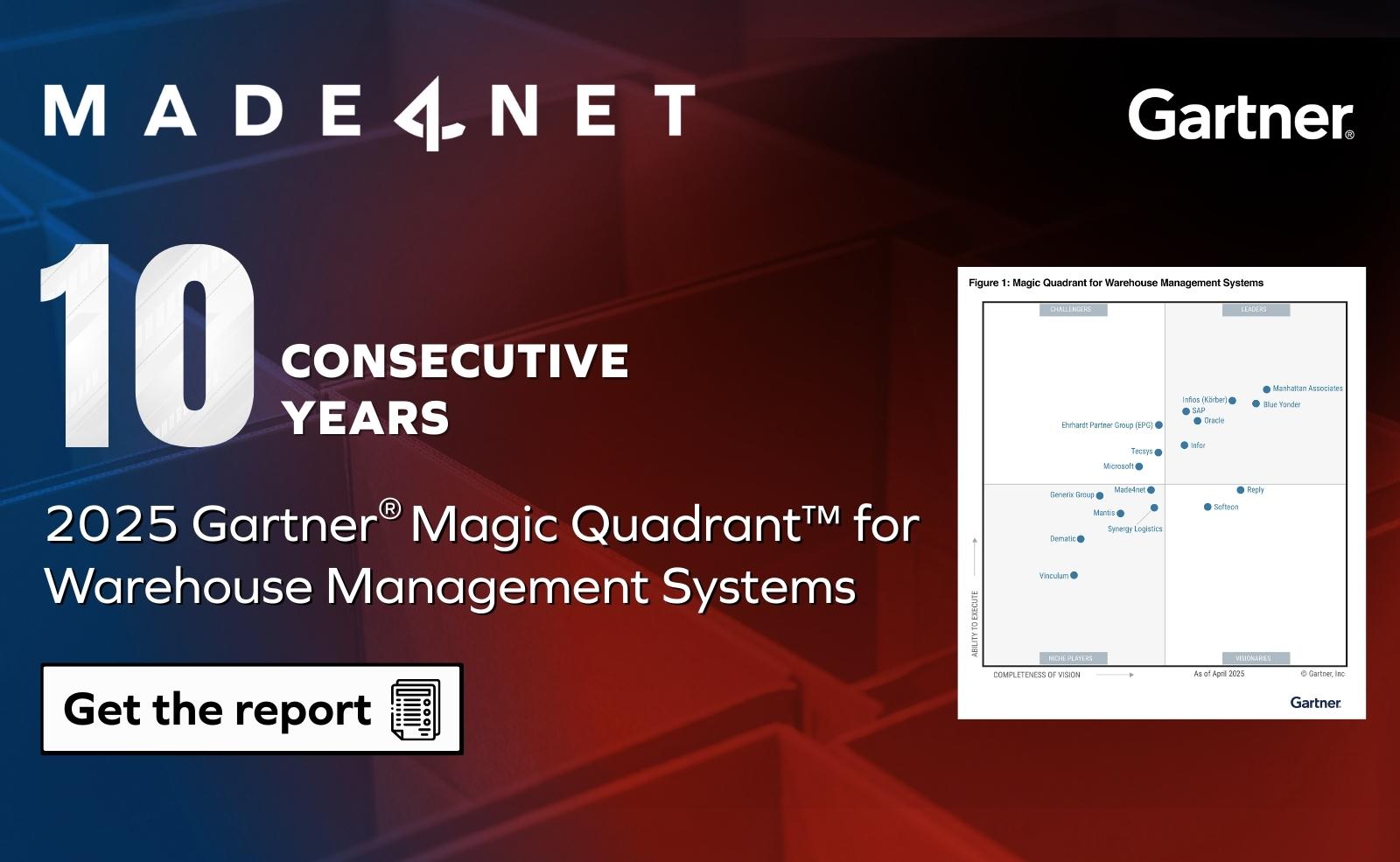
Big news! The highly anticipated Gartner® Magic Quadrant™ for Warehouse Management Systems (WMS) is here — and it’s packed with insights that supply chain leaders like you won’t want to miss.
Whether you’re exploring new WMS solutions or benchmarking your current system, this report offers a clear view of the WMS vendors and the innovations in the market.
To download the latest report, click here.
2025 Gartner Magic Quadrant for WMS: At a Glance
For this year’s report, Gartner evaluated over 80 WMS providers, but only 17 met the documented inclusion criteria and were ultimately recognized. We’re excited to share that Made4net has been named in the Gartner® Magic Quadrant™ for WMS for the 10th year in a row — a recognition we’re incredibly proud of as we continue to help businesses build smarter, more agile supply chains.
We feel the report will highlight that the WMS market is more dynamic than ever, with groundbreaking shifts and exciting innovations reshaping the landscape. Here are our top takeaways from the 2025 Gartner® Magic Quadrant™ for WMS—each one highlighting a trend you can’t afford to ignore.
- #1 – Today’s WMS buyers are looking for solutions that can do much more than manage inventory and fulfill orders.
- #2 – As market volatility persists, WMS buyers need agile, responsive partners to help them navigate the new normal
- #3 – WMS buyers are embracing the Cloud, but now they must choose the right model
- #4 – Cybersecurity is moving to the forefront for WMS buyers
- #5 – WMS buyers are getting tripped up by pricing
- #6 – How WMS Vendors incorporate AI is becoming a key differentiator
2025 Gartner Magic Quadrant for WMS: Takeaway #1
As demands on warehouse operations continue to grow, today’s WMS buyers are looking for solutions that can do much more than manage inventory and fulfill orders.
According to the report, “Although functionality remains the primary user evaluation criterion, there’s near-functional parity for basic core WMS capabilities across WMS providers.” Customers now focus more attention on the value-adding capabilities that surround core WMS capabilities.
Our take: Today’s WMS buyers are prioritizing platforms that go beyond basics. They seek robust capabilities such as value-added services, labor management, task interleaving, yard management, and dock scheduling. As labor shortages persist, organizations are also turning to automation to fill the gaps—driving a growing demand for WMS solutions that can seamlessly integrate with a wide range of automation technologies, both current and emerging. In addition, buyers are placing greater emphasis on usability, adaptability, and flexibility to ensure their systems can evolve with their business needs and ensuring scalability to support long-term growth.
2025 Gartner Magic Quadrant for WMS: Takeaway #2
As market volatility persists, WMS buyers need agile, responsive partners to help them navigate the new normal
This year’s Magic Quadrant states, “The dramatic changes embodied in ongoing market shifts will require considerable nimbleness and competency as well as investment on the part of vendors. Therefore, in this Magic Quadrant, we place strong emphasis on a vendor’s understanding of these market dynamics and its product strategies to support these needs.”
Our take: Market volatility ramped up with the onset of the pandemic and has shown no signs of slowing down. Ongoing disruptions—from extreme weather events to shifting trade policies and tariffs—continue to put pressure on warehouse operators to adapt quickly and efficiently. As a result, today’s WMS buyers must do more than just evaluate software features; they must closely examine how vendors respond to market change. In our opinion, vendors with a strong global presence are especially well positioned to monitor evolving conditions and stay ahead of the curve.
2025 Gartner Magic Quadrant for WMS: Takeaway #3
WMS buyers are embracing the Cloud, but now they must choose the right model
According to the report, “Cloud has become the preferred WMS deployment option, with more than 80% of new customers preferring cloud if the economics are reasonable.” However, there is still ongoing debate among vendors and buyers about whether multitenant SaaS is truly superior to dedicated cloud deployments.
Our take: Multitenant SaaS solutions are designed so that multiple customers share the same application infrastructure and code base, while their data remains isolated. This model offers benefits like faster innovation cycles, lower upfront costs, and simplified maintenance and upgrades. For many organizations, especially those looking for rapid deployment and scalability, multitenant SaaS is an attractive option.
On the other hand, dedicated cloud—also referred to as single-tenant or private cloud—gives each customer their own instance of the application and infrastructure. This can provide greater control, customization, and in some cases, enhanced security or performance for highly complex operations.
The choice between these models often comes down to a company’s specific needs around security, flexibility, customization, and IT governance. As the market matures, buyers are being more deliberate in evaluating which deployment model aligns best with their long-term operational and IT strategies.
Choosing between multitenant SaaS and dedicated cloud shouldn’t be a checkbox decision. Vendors should give buyers the flexibility to choose the cloud deployment that fits their needs — not the vendor’s. Because at the end of the day, warehouse operations don’t succeed on standardization. They succeed on precision, performance, and adaptability.
2025 Gartner Magic Quadrant for WMS: Takeaway #4
Cybersecurity is moving to the forefront for WMS buyers
Cybersecurity has long been top of mind for IT leaders, but only recently has the warehouse sector experienced its first major breaches—turning theoretical risks into real-world consequences. According to the report, “We see greater client concern over cybersecurity. One former and two current WMS Magic Quadrant vendors have been impacted by cyberattacks in the last two years. Two are still impacted: one in back-office functions and the other in some legacy but significant private cloud customer deployments. To date, there have been no reported breaches involving deployments on new public cloud instances supported by hyperscalers.”
Our take: WMS buyers must now go beyond evaluating functionality and scalability; they must also conduct thorough due diligence around data security, access controls, and vendor protocols.
2025 Gartner Magic Quadrant for WMS: Takeaway #5
WMS buyers are getting tripped up by pricing
Let’s face it—WMS solutions and their implementations have become increasingly expensive. There’s currently a great deal of confusion around how costs are structured, and pricing models continue to evolve. The report states, “Price variability is significant with cloud-based WMSs, where subscription-based pricing models dominate and de facto cross-industry standards are yet to solidify.”
The report also states that, “Flexibility in commercial terms is becoming more compelling to customers as there is a greater focus on affordability. Some vendors are retaining high pricing, while others are aggressively competing on price to gain market share. Still others are offering seasonal software and hardware subscriptions, which are appealing to companies with significant seasonal fluctuations.”
Our take: With no clear, cross-industry standards in place, buyers may find it difficult to make apples-to-apples comparisons. Until more transparency emerges, buyers should be mindful to assess all costs related to the software, including the cost of implementation in addition to subscription fees. WMS buyers should also note the difference in the breadth of software offerings. Some vendors offer more modules and functionality with some supply chain convergence, which also impacts the price accordingly.
2025 Gartner Magic Quadrant for WMS: Takeaway #6
How WMS Vendors incorporate AI is becoming a key differentiator
As warehouse operations grow more complex, the role of artificial intelligence (AI) in WMS platforms is quickly moving from “nice to have” to essential. According to the report, “Many of the vendors in this Magic Quadrant, including megavendors, are continuing to build out new use cases for various forms of AI, notably most recently GenAI and vision AI.”
Our take: Over time, a vendor’s ability to embed AI in practical, scalable ways will become a major differentiator—separating those who drive innovation from those who simply keep pace. Made4net customers are deploying AI vision technology and Autonomous Mobile Robots (AMRs), functioning intelligent agents that can perceive, adapt, and make real-time decisions. AI-driven technology is no longer a futuristic concept—it’s transforming warehouse operations today.
Get Your Copy of the 2025 Gartner Magic Quadrant for WMS
As the WMS landscape continues to evolve, staying informed is more critical than ever. Use this year’s Magic Quadrant as a guide to align your technology investments with long-term operational goals—and choose a partner that can grow with you. We invite you to download your complimentary copy today.
Disclaimer:
Gartner, Magic Quadrant for Warehouse Management Systems, Simon Tunstall, Dwight Klappich, Rishabh Narang, Federica Stufano, May 1, 2025.
GARTNER is a registered trademark and service mark of Gartner, Inc. and/or its affiliates in the U.S. and internationally, and MAGIC QUADRANT is a registered trademark of Gartner, Inc. and/or its affiliates and are used herein with permission. All rights reserved.
Gartner does not endorse any vendor, product or service depicted in its research publications, and does not advise technology users to select only those vendors with the highest ratings or other designation. Gartner research publications consist of the opinions of Gartner’s research organization and should not be construed as statements of fact. Gartner disclaims all warranties, expressed or implied, with respect to this research, including any warranties of merchantability or fitness for a particular purpose.


